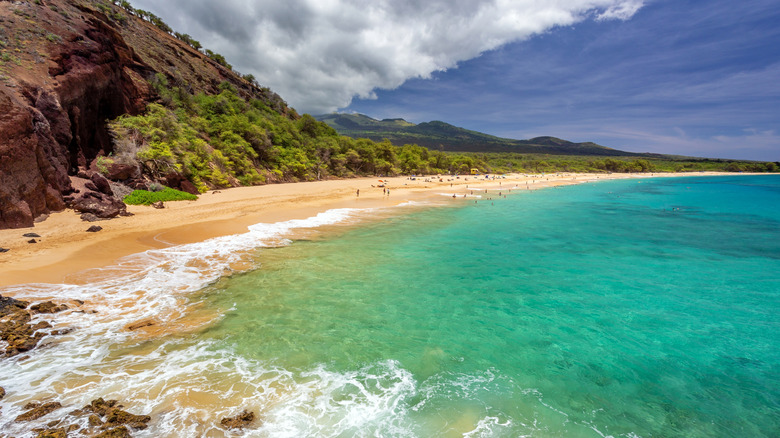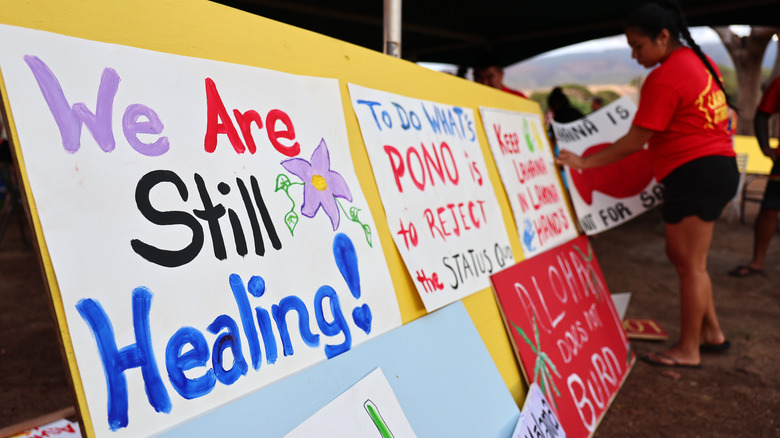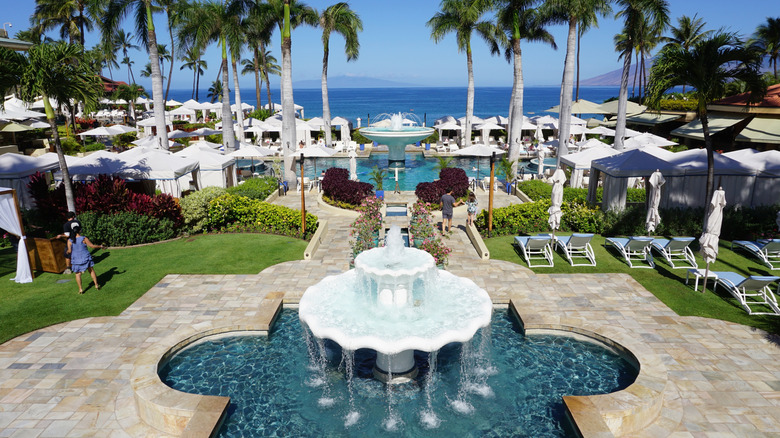One Hawaiian Island Is Struggling To Keep Up With Its Decreasing Number Of Tourists
Hawaii has been a popular vacation destination for generations. The first tourists began visiting in the late 1800s, long before Hawaii became a U.S. state in 1959. After WWII, the number of yearly visitors steadily increased, eventually reaching 1 million in 1967. Tourism peaked in 2019 when over 10 million people visited, and then sharply declined due to the COVID-19 pandemic. Although locals have struggled with the effects of overtourism, the sharp decrease in visitors has also had negative economic impacts. The island of Maui is taking the hit particularly hard, especially after devastating wildfires that occurred in August of 2023.
Travelers have begun returning to Hawaii over the past few years, but the visitor numbers are still much less than they were pre-pandemic. Maui's tourism industry isn't recovering as quickly as the rest of the islands. In 2024, the number of Maui visitors decreased by 6% from 2023, whereas the state as a whole saw a slight increase in total visitors. Meanwhile, prices in Maui are continuing to climb, which further discourages tourism.
The lack of visitors is beginning to take its toll on the tropical Hawaiian island. "The ongoing decline in visitor arrivals has affected local businesses, jobs, and economic stability," the Hawaii Tourism Authority chair, Mufi Hannemann, told SFGate in an interview. James Tokioka, who serves as the director of the Hawaii Department of Business, Economic Development, and Tourism, assured visitors that Maui is once again open for tourism and has been for some time. "The county of Maui and the state of Hawaii welcome all of our friends and visitors from California and all over the world," he said.
Tourists may be confused about whether or not it's appropriate to return to Maui
It's difficult to know exactly how soon is too soon to visit a destination after a natural disaster, and many would-be tourists may think they're being respectful by staying away from Maui. The wildfires that erupted on the island on August 8, 2023, were catastrophic. They were the deadliest fires in the United States in the past hundred years, and over 102 people were killed. The beautiful town of Lahaina was reduced to ash and rubble.
In the days and weeks immediately following the fires, locals were understandably critical of tourists who chose to continue their vacations as if nothing had happened. Jason Momoa, a famous actor who was born in Hawaii and has Native Hawaiian heritage, posted on Instagram urging tourists to stay away. "Maui is not the place to have your vacation right now. Do not travel. Do not convince yourself that your presence is needed on an island that is suffering deeply," he wrote (via BBC).
An anonymous local also told the BBC, "The same waters that our people died in three days ago are the same waters the very next day these visitors –– tourists –– were swimming in ... Nobody is having fun in tragedy and continuing their lives like nothing has happened." Their words may have had the desired effect, because the usual crowds haven't returned. In 2024, about 2,345,288 people traveled to Maui, which is a significant decrease from 2019, when more than 3 million people visited. Ashley Davis, a local business owner, told SFGate that "visitor numbers are significantly lower than in previous years due to the loss of Lahaina and the prevailing narrative discouraging travel to West Maui."
Higher prices are deterring travelers
Another potential reason tourism hasn't rebounded is that it has become significantly more expensive to travel to Hawaii. Many travelers simply can't afford the high cost of accommodations. In 2024, the average hotel prices in Hawaii were up nearly 29% from 2019. According to the state Tourism Data Warehouse, the average daily room rates across the islands were $364 per night. Maui's prices were even higher. For a city stay in Maui, the average nightly rate was $544 per night. As prices have soared, occupancy has decreased. In 2024, the average occupancy rate was just over 61% in Maui, compared to almost 78% in 2019. Increased prices are likely leading to decreased demand.
Local business owners agree that the prices are causing travelers to go elsewhere. In an interview with SFGate, a local business owner named Joan Channon said that she's had tourists tell her that they used to visit every year, but can no longer afford to. "I think the hotels and accommodations need to realize, if we want to keep guests, we have to lower our prices, and they need to lower their expectations and their demands, their profit demands, a little bit, like give a little," she said.
Some local news outlets are going so far as to call Maui's tourism problems a crisis. Tourism accounts for around 40% of Maui's GDP. Even as tourism officials strongly encourage travelers to return, the Mayor of Maui aims to address the housing crisis by eliminating thousands of short-term rentals on the island, which could further reduce places to stay in Hawaii on a budget. The mixed messages may be causing prospective travelers to plan more affordable trips elsewhere.


